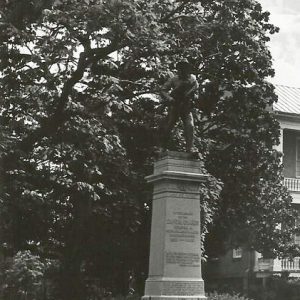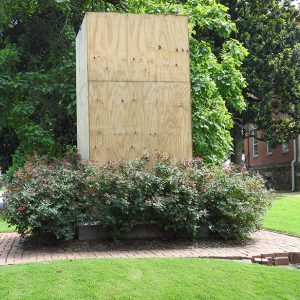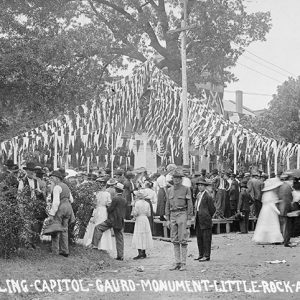calsfoundation@cals.org
Memorial to Company A, Capital Guards
aka: Lest We Forget
The Memorial to Company A, Capital Guards is a Civil War commemorative monument created by sculptor Rudolf Schwarz. It was dedicated in City Park in Little Rock (Pulaski County) during the 1911 United Confederate Veterans Reunion. The monument was listed on the National Register of Historic Places on April 26, 1996. The base of the monument was vandalized in June 2020, and the sculpture of the soldier was moved to storage.
Little Rock was selected to host the twenty-first annual United Confederate Veterans Reunion (May 16–18, 1911), and the Robert C. Newton Camp of the Sons of Confederate Veterans (SCV) chose to use that occasion to dedicate a monument to the Little Rock men who had served in the Capital Guards, which was Company A of the Sixth Arkansas Volunteer Infantry Regiment (CS), and fought most of the Civil War in Major General Patrick Cleburne’s division. They hired Austrian-born sculptor Rudolf Schwarz of Indiana, who had sculpted numerous Union monuments in that state, to create the memorial.
More than 100,000 people descended on Little Rock for the reunion, and the veterans stayed in a large encampment in City Park (now MacArthur Park) named Camp Shaver for Colonel Robert G. “Fighting Bob” Shaver, who had led the Seventh Arkansas Infantry (CS) and who participated in the reunion. When the monument was dedicated at 10:00 a.m. on Wednesday, May 17, 1911, more than 6,000 attended the ceremony, including three of the five surviving members of Company A.
The keynote speech was given by the Reverend C. P. Fletcher, pastor of Winfield Memorial Church, who said, as transcribed in the May 18, 1911, Arkansas Gazette: “God forbid that we should ever forget the achievements of the old South, which welded the destiny of this nation 200 years, which gave us our first president and gave us the Declaration of Independence. Ladies and gentlemen, the old South was the land of bravery, chivalry, romance, blue blood, cotton, corn, negroes and watermelons. Alas, there were too many negroes and not enough watermelons. The only difference between the North and South now is the difference between hot biscuits and cold light bread. We are living now, thank God, under one flag, in peace and prosperity.”
Mary Fletcher and Helen Frances Peay, daughter and granddaughter, respectively, of two men who served as captains of Company A, pulled a pair of ribbons to remove the cloth covering the monument and the blossoms of 20,000 roses fell as the University of Arkansas band played “Dixie.” Afterward, the monument was presented to Mayor Charles Taylor, who accepted it on behalf of the city of Little Rock.
The Memorial to Company A, Capital Guards features a bronze statue of a Confederate soldier charging forward with rifle and bayonet. It stands atop a sixteen-foot granite base inscribed on its front side: CSA / LEST WE FORGET / TO THE MEMORY / OF THE / CAPITAL GUARDS / COMPANY A / SIXTH ARKANSAS INFANTRY / CLEBURNE’S DIVISION / 1861–1865 / ‘WHEN HIS DIVISION DEFENDED / NO ODDS COULD BREAK ITS LINES / WHEN IT ATTACKED, NO NUMBERS RESISTED ITS ONSLAUGHT.’ / GENERAL WM. J. HARDEE. Below that is the inscription: ERECTED BY FRIENDS AND RELATIVES OF THE / CAPITAL GUARDS AND THE CITIZENS OF LITTLE ROCK UNDER THE AUSPICES OF THE / ROBERT C. NEWTON CAMP, UNITED SONS OF / CONFEDERATE VETERANS, MAY FIFTEENTH / NINETEEN HUNDRED AND ELEVEN. It is unclear if the soldier statue was attached at the time of the dedication, as the Arkansas Gazette article on the unveiling states only that a “tall granite shaft stood revealed.”
In September 1940, the names of the men who served in the Capital Guards were engraved on the rear of the Barre granite base, with Little Rock’s Monahan & Son monument company using the recently developed sand-blasting method to etch the names into the stone.
The Memorial to Company A, Capital Guards stood in MacArthur Park in front of the old U.S. Arsenal Building that now houses the MacArthur Museum of Arkansas Military History for more than 109 years until the base was vandalized on June 15, 2020, in the wake of nationwide protests against police violence and Confederate symbols.
After the vandalism, the sculpture of the soldier was removed and put into storage three days later, and the damaged base was encased in a plywood shell. Little Rock Mayor Frank Scott stated: “This statue…was erected during the United Confederate Veterans Reunion in 1911, a period of rampant segregation, inequality, and oppressive Jim Crow laws. It does not represent the values of our city today nor the diverse citizenry who stand for unity and justice for all.” A marble marker commemorating the execution of Confederate spy David O. Dodd and a 1936 bench placed by the Children of the Confederacy were removed from behind the museum the following month.
It was reported in November 2020 that the Arkansas Historic Preservation Program had filed a request to de-list the monument from the National Register, and the request was endorsed by the Little Rock Historic District Commission. The monument was removed from the National Register on May 12, 2021. Later that month, however, an attorney representing the SCV and the United Daughters of the Confederacy threatened to sue the city of Little Rock on the basis of a bill signed into law by Governor Asa Hutchinson earlier that year, the “Arkansas State Capitol and Historical Monument Protection Act,” unless the Capital Guards monument, as well as the Dodd marker and 1936 bench, were returned to their original locations. In early January 2023, James Frank Clark III did file suit against the City of Little Rock, claiming that the removal of the monument violated the 2021 state law. On June 10, 2025, Pulaski County Circuit Judge Patricia James ordered the city to seek a waiver from the Arkansas History Commission for the removal of the monument, as mandated by law.
For additional information:
Flaherty, Joseph. “Little Rock Sued in Monument Dispute.” Arkansas Democrat-Gazette, January 12, 2023, pp. 1B, 3B. Online at https://www.arkansasonline.com/news/2023/jan/12/city-of-little-rock-sued-over-removal-of/ (accessed January 12, 2023).
———. “Markers’ Removal Draws Suit Threat.” Arkansas Democrat-Gazette, May 20, 2021, pp. 1B, 3B. Online at https://www.arkansasonline.com/news/2021/may/20/markers-removal-draws-suit-threat/ (accessed January 12, 2023).
———. “Markers’ Removal Stands, LR Replies.” Arkansas Democrat-Gazette, May 21, 2021, pp. 1B, 5B. Online at https://www.arkansasonline.com/news/2021/may/21/markers-removal-stands-lr-replies/ (accessed January 12, 2023).
Herzog, Rachel. “List Asked to Oust Confederate Statue.” Arkansas Democrat-Gazette, November 6, 2020, p. 3B.
———. “LR Park Markers for Dodd Removed.” Arkansas Democrat-Gazette, July 10, 2020, pp. 1B, 8B.
Logan, Charles Russell. “Something So Dim It Must Be Holy”: Civil War Commemorative Sculpture in Arkansas, 1886–1934. Little Rock: Arkansas Historic Preservation Program, 1996. Online at https://www.arkansasheritage.com/arkansas-preservation/programs/publications (accessed May 22, 2025).
Mahmoud, Amir. “LR Told to Get Statue Waiver.” Arkansas Democrat-Gazette, June 13, 2025, pp. 1B, 2B. Online at https://www.arkansasonline.com/news/2025/jun/12/judge-orders-little-rock-to-seek-waiver-for/ (accessed June 13, 2025).
———. “Mayor: Public Safety Is Cause of Statue’s Pull.” Arkansas Democrat-Gazette, May 23, 2025, pp. 1B, 5B. Online at https://www.arkansasonline.com/news/2025/may/22/little-rock-mayor-testifies-in-trial-over-city/ (accessed May 23, 2025).
———. “Trial Date Set over Statue’s Removal.” Arkansas Democrat-Gazette, May 22, 2025, pp. 1B, 8B. Online at https://www.arkansasonline.com/news/2025/may/22/bench-trial-over-removed-little-rock-confederate/ (accessed May 22, 2025).
“Sand-Blast Method Used to List Names of Capital Guards.” Arkansas Gazette, September 5, 1940, p. 14.
Sanders, William, and Nyssa Kruse. “Confederate Statue Removed in LR.” Arkansas Democrat-Gazette, June 19, 2020, pp. 1A, 6A.
“Shaft to Capital Guards Unveiled.” Arkansas Gazette, May 18, 1911, p. 3.
Towns, W. Stuart. Arkansas Civil War Heritage: A Legacy of Honor. Charleston, SC: The History Press, 2013.
Mark K. Christ
Central Arkansas Library System
 Early Twentieth Century, 1901 through 1940
Early Twentieth Century, 1901 through 1940 Historic Preservation
Historic Preservation Capital Guards Memorial
Capital Guards Memorial  Capital Guards Memorial Vandalism
Capital Guards Memorial Vandalism  Capital Guards Monument Dedication
Capital Guards Monument Dedication 



Comments
No comments on this entry yet.